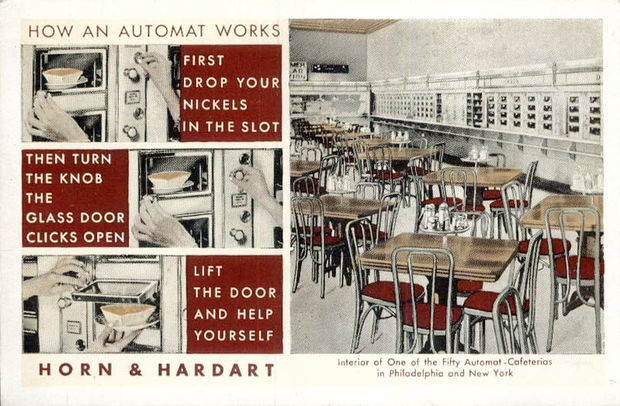It sounds futuristic: at a fully-automatic restaurant that opened its doors in Midtown earlier this week, you can order, pick up and eat your $6.95 quinoa bowl without talking to a server or cashier.
Eatsa, located at 285 Madison Ave. between 40th and 41st streets, is the East Coast anchor for a San Francisco-based chain popular among tech industry employees.
But its format — which entails customers opening small locker doors to access their meals — will ring familiar to New Yorkers who remember the city's last automat, which closed in 1991.
Decidedly high-tech for the pre-computer era, automats featured chrome and glass vending machines that displayed beef stew, mac-and-cheese, and huckleberry pie in their own small, well-lit compartments.

In the mid-20th century, automats provided quick, cheap lunches for the working New Yorker. Before 1952, most items cost a single nickel; heavier fare like hamburgers, eggs and bacon cost two. No waiters meant no tips.
Although newspaper archives suggest automated restaurants existed in New York before 1912, business partners Joseph Horn and Frank Hardart typically get the credit for establishing the city's first automat that year.

Customers would slip a coin into a slot, turn a knob, lift a hinged window and remove their food, which was prepared and stocked by staff working behind the scenes.

An advertisement for the first Horn & Hardart restaurant, placed in several New York City papers
They took their inspiration from a German eatery called Quisiana Automat, envisioning a dining experience just as efficient as any factory assembly line. The first Horn & Hardart automat opened in Philadelphia.
In New York, the Horn & Hardart flagship Times Square location and its offshoots attracted diners from all walks of life: Wall Street bankers, municipal employees, socialites, police officers, aspiring actors, playwrights.

"The Maxim's of the disenfranchised" was how Neil Simon described the automat in 1987, referring to a Parisian restaurant with a similar emphasis on Art Deco décor.
An element of that ornamentation were the Italian brass spigots, shaped like dolphin heads, that served the Automat's greatest attraction: smooth drip coffee, brewed freshly every 20 minutes.

But java couldn't save Horn & Hardart's business model as city dwellers moved out to the suburbs, office buildings opened their own cafeterias, and other fast-food chains entered the market in the 1950s and 60s. By the 1970s, the company was replacing automats with Burger King franchises.
In Eatsa, a one-time New York institution may be reincarnated.

























